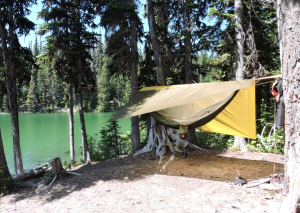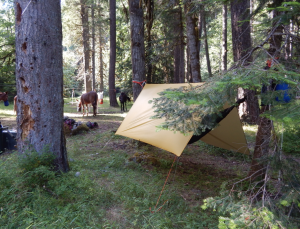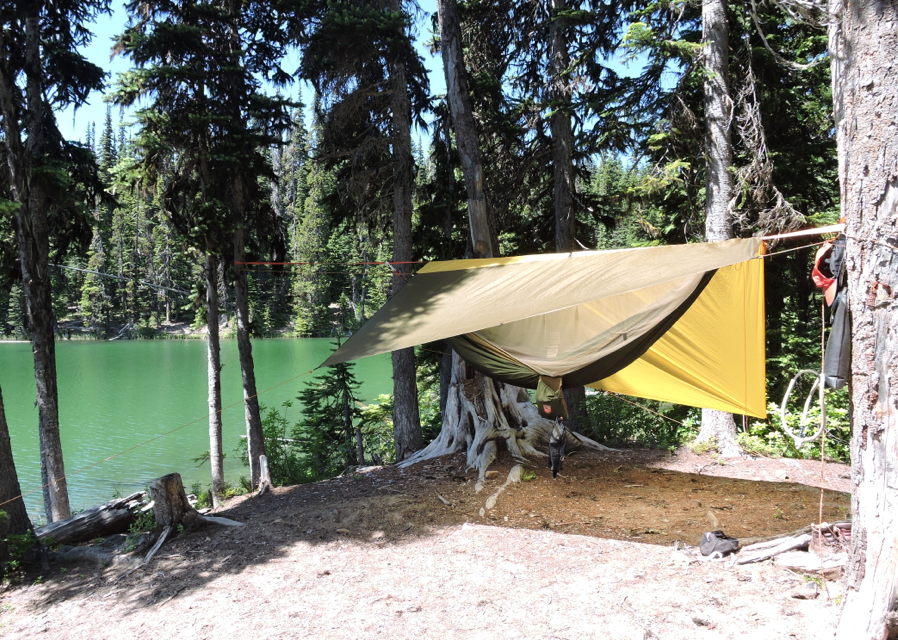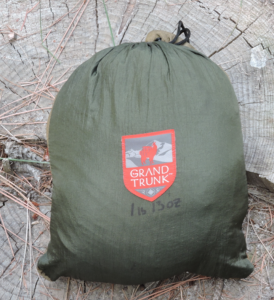 When riding the backcountry across remote mountain ridges and miles of seemingly untouched terrain, being comfortable is one of your top priorities. A good nights sleep can make the difference between a beautiful day on the trail or a rough, miserable, day spent battling back pain.
When riding the backcountry across remote mountain ridges and miles of seemingly untouched terrain, being comfortable is one of your top priorities. A good nights sleep can make the difference between a beautiful day on the trail or a rough, miserable, day spent battling back pain.
Tents, Bivy Sacks, and Hammocks Oh My!
With the wide variety of options available for backcountry shelters it’s important to know what best fits your needs before going online and ordering the cheapest option. I spend a fair amount of the summer on the trail and in the backcountry so when I first talked with a Pacific Crest Trail through-hiker about hammocks for camping I was intrigued to say the least. At that point, for me, a hammock was a wonderful backyard nap instrument and that was it. What I didn’t realize was that in the past few years hammock technology has made huge steps forward and can provide a very versatile and economical shelter suitable for a wide variety of situations. The unique features that hammocks offer are also quite helpful when it comes to comfort and pack-ability. These many benefits make hammocks sound like the perfect option for horse camping. Let’s take a more in depth look into their advantages.
A hammock can be set up anyplace where there’s an elevated attachment point. For most of us that means trees. This being the case you can quickly see how a hammock isn’t limited to that magic unicorn of a campsite where the ground is clear, level, and free of rocks, roots, and spiders. This versatility opens up many wonderful camping areas that previously weren’t accessible.
Most hammocks are much lighter than the average tent and with no rigid poles can be stuffed into a very small area. This makes them perfect for campers wanting to conserve weight and space. This makes them ideal for riders camping off of their riding animals as well as packers wanting to save some space. An additional point worth mentioning is how quick a hammock can go from pack to “home sweet home”. The setup time for a hammock can be much less than that of setting up a tent. When the weather’s fine this isn’t a big deal but when it’s cold and the rain clouds are rushing in it’s a wonderful thing.
Apart from the lightweight, small volume, and ease of setup it’s the comfort factor of hammocks that keeps me elevated. No hard rocks digging into your back, no slope that oozes you downhill during the night, and no worries about wet ground seeping in. As long as you’ve got a couple of trees nearby you can choose to slumber anywhere that you like.
The Learning Curve – The first few times that you use your hammock it will take a bit of getting used to. And there is a bit of a knack to master for a comfortable nights sleep. Let’s discuss some of the fine points of hammocking.
- Cold Butt Syndrome –Just like when you’re sleeping on the ground the insulation of your sleeping bag will be compressed beneath you. Compressed insulation equals no insulation. To combat this there are a variety of solutions from custom made under quilts that hang beneath the hammock to a low cost closed cell foam pad that you lay on inside the hammock.
- The Squeeze – First time hammockers tend to stretch their hammock too tightly in an effort to make the hammock straight. It generally doesn’t work. Instead, hang your hammock with a deep sag. It’s this sag that allows you to lay flat and even sleep on your side.
- The Fall – “I’d fall out” is often the first thing I hear from the uninitiated. The solution is to set up your hammock with a deep sag. Do this and it’s almost impossible to fall out.
- Singles Only – One of the downfalls of hammocking is that, at this point, it’s very difficult for couples to snooze together without some discomfort.
 As you can see hammocks, like most things, do have some downfalls. Squeezing two people into a hammock can be daunting and it’ll be really cramped. Staying warm can be a challenge. My first hanging experience was “memorable”. I had taken the horses high into the Norse Peak Wilderness in Washington’s Cascade Range. What I didn’t think about was the amount of heat loss from the air blowing under and around the hammock. It was a rude introduction to the reality of Cold Butt Syndrome and I spent the longest part of the night huddled by the campfire; not fun. I’ve since refined the system and thankfully haven’t repeated those particular mistakes.
As you can see hammocks, like most things, do have some downfalls. Squeezing two people into a hammock can be daunting and it’ll be really cramped. Staying warm can be a challenge. My first hanging experience was “memorable”. I had taken the horses high into the Norse Peak Wilderness in Washington’s Cascade Range. What I didn’t think about was the amount of heat loss from the air blowing under and around the hammock. It was a rude introduction to the reality of Cold Butt Syndrome and I spent the longest part of the night huddled by the campfire; not fun. I’ve since refined the system and thankfully haven’t repeated those particular mistakes.
My Setup – Of the three hammocks I have the one that I use most often is the Grand Trunk Skeeter Beeter Pro. It weighs the least, packs smaller, and costs less than any of the others. And it comes with a built in mosquito net that really helps to insure a good nights rest. With the addition of a small tarp this setup offers me a rainproof, mosquito proof shelter plus a covered line to dry and protect any camping gear or tack.
Overall, apart from some temperature and space restrictions, I’ve found that hammocks are an excellent alternative to the classic tent approach that many back country horsemen utilize. Hammocks can provide a comfortable and versatile solution for anyone from the weekend rider to packers venturing into the backcountry for weeks at a time. Happy horse camping!



